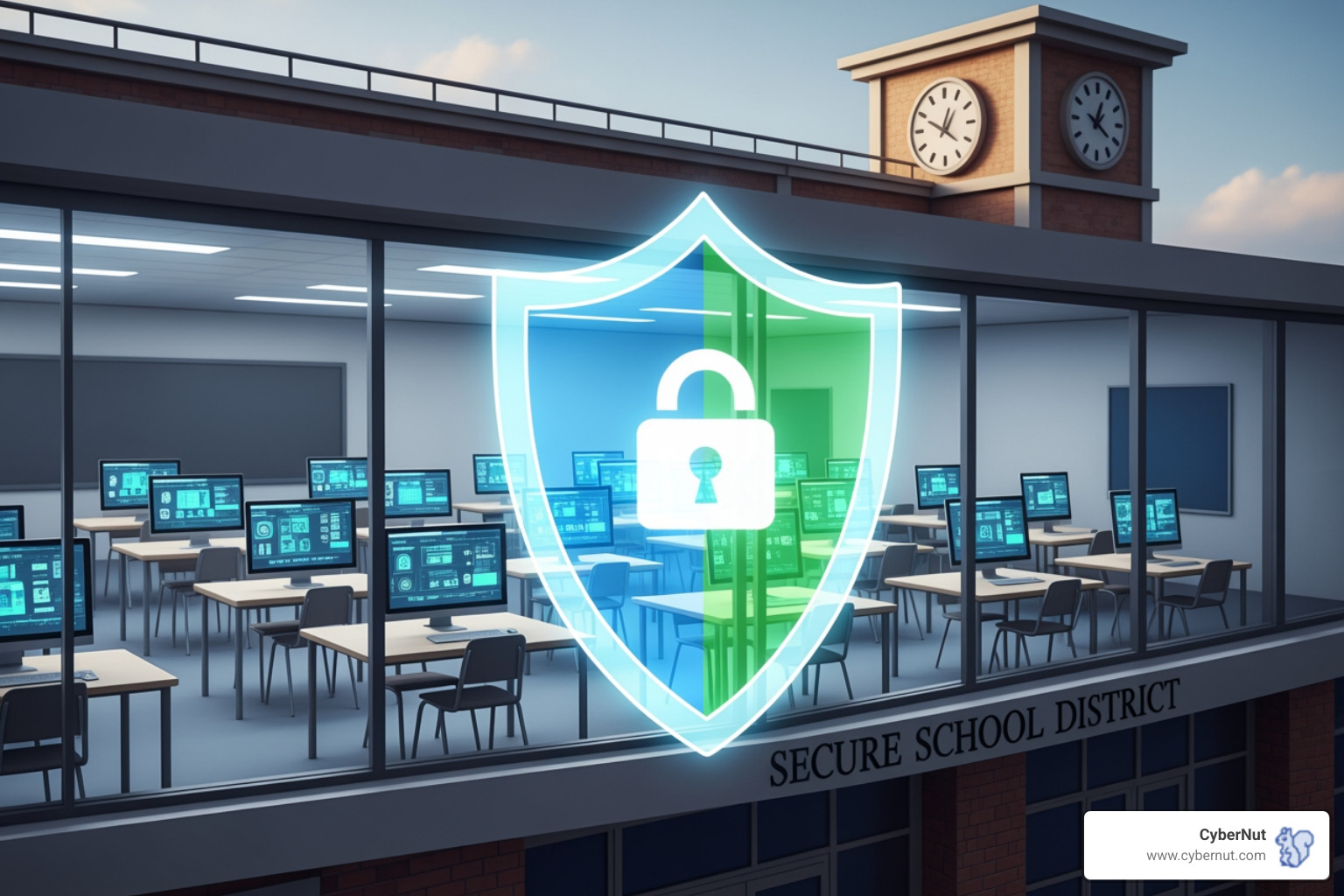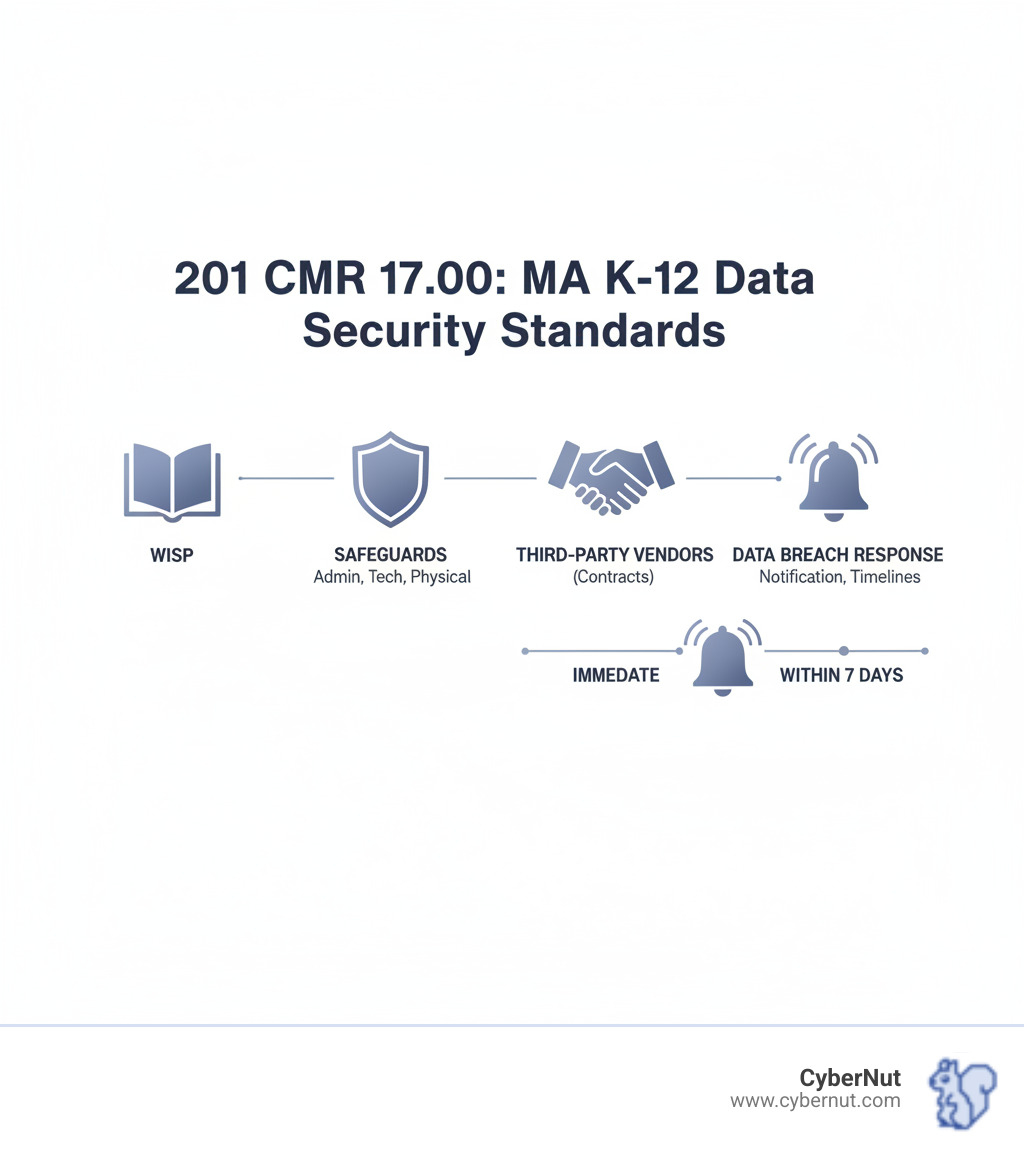
Oliver Page
Case study
November 12, 2025

All About 201 CMR 17.00: Data Security Standards for Massachusetts K–12 Schools is essential knowledge for every IT director in the Commonwealth. This regulation is the framework that protects your students' Social Security numbers, staff financial information, and other sensitive records.
Quick Answer: What You Need to Know
School districts are prime targets for cybercriminals because they hold vast amounts of personal information. A data breach in an educational institution is significantly more costly per record than in other industries. The good news is that 201 CMR 17.00 provides a clear roadmap for protecting your community's data by taking reasonable steps based on your district's size, resources, and the data you handle.
This guide breaks down what the regulation requires, how it interacts with laws like FERPA, and the practical steps you can take to protect your students and staff. Data security isn't just about avoiding fines—it's about maintaining your community's trust.

All About 201 CMR 17.00: Data Security Standards for Massachusetts K–12 Schools terms to know:
201 CMR 17.00, formally titled "Standards for the Protection of Personal Information of Residents of the Commonwealth," implements state law M.G.L. c. 93H to prevent identity theft. It's your blueprint for securing sensitive information, whether it's in a filing cabinet or in the cloud.
The regulation's objectives are to ensure the security of personal information, protect against threats, and guard against unauthorized access. Its scope is broad, applying to all organizations—including school districts—that own or license personal information about Massachusetts residents. If your district handles this data for students, staff, or parents, you must comply.
Schools are attractive targets for cybercriminals due to the volume of sensitive data they manage, from student health information to staff payroll details. A data breach can cost millions and severely damage your district's reputation. This regulation provides a clear roadmap for protection. You can review the official text of 201 CMR 17.00 and learn more about the legislative background in our guide on What to Know About M.G.L. 93H for Massachusetts School Data Privacy.
Under All About 201 CMR 17.00: Data Security Standards for Massachusetts K–12 Schools, "personal information" has a precise definition. It means a Massachusetts resident's first name and last name (or first initial and last name) in combination with one of the following:
The key is the "combination." A student's name alone is not personal information under this rule. But once linked to an SSN or a parent's financial account for school fees, it triggers the full requirements of 201 CMR 17.00.
For student data, this applies to federal aid applications or special program enrollments requiring an SSN. For staff data, it covers all payroll and direct deposit information linking an employee's name to their SSN and bank account details. Understanding this definition helps you focus your security efforts where they matter most.
Massachusetts schools must steer a complex web of privacy laws. The most familiar is the Family Educational Rights and Privacy Act (FERPA), a federal law protecting the privacy of student education records.
Here's the critical point: complying with FERPA does not automatically make you compliant with 201 CMR 17.00. They are different laws with different goals. FERPA focuses on student privacy (who can see records), while 201 CMR 17.00 sets specific security standards (how to protect data from a breach).
The bottom line is you need both. For more on FERPA, see our guide: All About FERPA: The Federal Student Privacy Law That Still Matters in 2025.
Additionally, schools must comply with 603 CMR 23.00: Student Records, a state regulation governing the handling of student records. Learn more in our article: All About 603 CMR 23.00: Student Records Regulations in Massachusetts. Even if your school is HIPAA compliant, you are not exempt from 201 CMR 17.00. A comprehensive data protection strategy requires a layered approach that addresses all applicable laws.
Your Written Information Security Program (WISP) is the master playbook for protecting your district's sensitive data. Under 201 CMR 17.00, creating, implementing, and maintaining a WISP is not optional—it's the law. A WISP is a comprehensive written plan that details your administrative policies, technical controls, and physical security measures.

Your WISP is your primary evidence of compliance with All About 201 CMR 17.00: Data Security Standards for Massachusetts K–12 Schools. It forces proactive risk management, helping you identify vulnerabilities before they become problems. It also brings consistency and accountability to your organization by setting clear rules for everyone.
The regulation allows for a risk-based approach, meaning your WISP can be customized based on your district's size, resources, and the amount of personal information you handle. A small district's WISP will look different from that of a large urban one. A good WISP is also a living document, designed to evolve with new technologies and threats.
CyberNut offers resources like our Data Security and Privacy Plan to help you build a foundation for your school's specific needs.
To meet the requirements of 201 CMR 17.00, your district's WISP must include these essential components:
After developing your WISP, you must implement the safeguards that protect your data. All About 201 CMR 17.00: Data Security Standards for Massachusetts K–12 Schools requires three layers of protection: administrative, technical, and physical. The regulation uses a "reasonableness" standard, meaning your safeguards should be appropriate for your district's size, resources, and the sensitivity of the data you handle. This layered approach ensures that if one safeguard fails, others are in place to prevent a breach.
Administrative safeguards focus on the human side of security. They include:
Technical safeguards are the digital locks and alarms protecting your electronic data. Key measures include:
Physical security remains crucial for protecting data in all its forms. These safeguards include:
Implementing all three types of safeguards creates a robust security posture that protects your district from the many Cybersecurity Risks: Protecting K-12 Schools From Evolving Threats.
Your data security strategy must extend beyond your own network to include every vendor and cloud service that touches your data. Proactive risk management is not just smart—it's a requirement under All About 201 CMR 17.00: Data Security Standards for Massachusetts K–12 Schools. A single security incident can lead to massive costs and irreparable reputational damage. For a deeper dive into the threats, see our guide on Cybersecurity Risks: Protecting K-12 Schools From Evolving Threats.

Your district is responsible for ensuring that vendors—like your student information system, cloud storage provider, or payroll service—protect the personal information they handle on your behalf. You cannot outsource your compliance obligations.
This requires:
When a security incident occurs, your WISP's incident response plan must be activated immediately. A "breach of security" under M.G.L. c. 93H is the unauthorized acquisition of unencrypted data that creates a substantial risk of identity theft or fraud.
If a breach occurs, you must:
Timeliness is critical. Delays in notification increase the potential harm to individuals and your district's legal exposure.
Ignoring 201 CMR 17.00 is a significant risk. The consequences include:
Compliance isn't just about avoiding penalties—it's about protecting the people who depend on you.
Let's clarify some of the most common questions Massachusetts K-12 schools have about 201 CMR 17.00.
The regulation applies to student data when it meets the specific definition of "personal information": a student's name combined with their Social Security number, driver's license/state ID number, or financial account information. Most routine student data (grades, attendance) doesn't trigger this on its own.
However, processes like collecting SSNs for federal aid applications or parent financial data for school fees fall squarely under the regulation. Your WISP and all associated safeguards must protect this data. This aligns with the principles in All About 603 CMR 23.00: Student Records Regulations in Massachusetts.
A key strategy is data minimization: only collect and retain the personal information that is absolutely necessary. The less sensitive data you store, the smaller your risk.
Your WISP is a living document. All About 201 CMR 17.00: Data Security Standards for Massachusetts K–12 Schools requires a review of your security measures at least annually.
However, you should also trigger a review immediately after:
The goal is continuous improvement. Document all reviews and changes to demonstrate your good-faith compliance efforts.
No, absolutely not. This is a common and dangerous misconception. FERPA and 201 CMR 17.00 are separate laws with different requirements.
FERPA is a federal law focused on the privacy of student education records. It governs who can access student data and when it can be shared. It is about access rights and consent. Learn more in our guide, All About FERPA: The Federal Student Privacy Law That Still Matters in 2025.
201 CMR 17.00 is a Massachusetts regulation focused on security. It mandates specific technical and administrative safeguards—like encryption, firewalls, and a WISP—that FERPA does not explicitly require.
To be fully compliant, you must meet the obligations of both laws. FERPA tells you who can see the data; 201 CMR 17.00 tells you how to protect it from being stolen. One without the other leaves your district exposed.
All About 201 CMR 17.00: Data Security Standards for Massachusetts K–12 Schools is more than a checklist; it's a framework for responsible data stewardship. Compliance is an ongoing journey that requires developing a WISP, implementing layered safeguards, and maintaining constant vigilance.
Your security is only as strong as your people. The human element is often the first line of defense and the most common vulnerability. A single click on a phishing email can bypass the most advanced technical defenses.
Building a culture of cybersecurity is about empowering every staff member to recognize threats and make secure choices. At CyberNut, we specialize in this. Our automated, gamified micro-trainings are designed for busy K-12 staff, making cybersecurity awareness an engaging and continuous practice, not a tedious annual task.
Ready to strengthen your district's human firewall? Start with our complimentary phishing audit to get a clear snapshot of your school's current vulnerability. It's a no-obligation first step toward building a more secure environment.
From there, explore the wealth of cybersecurity strategies and resources we've developed for schools like yours. Compliance with 201 CMR 17.00 isn't just about avoiding fines—it's about honoring the trust your community places in you. Together, we can build a culture of security, one empowered staff member at a time.

Oliver Page

Some more Insigths


Back